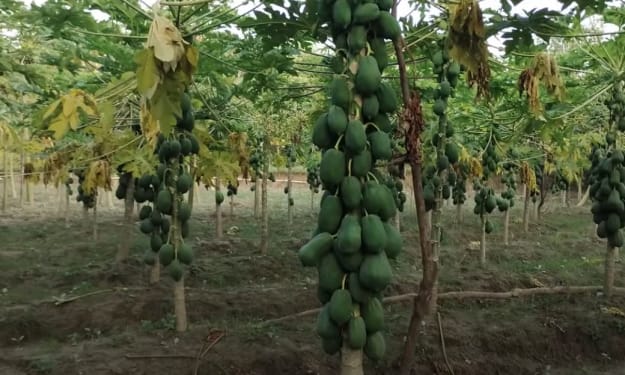
Eggplant is cultivated more or less in almost all the districts of Bangladesh. Many of us don't know how to grow eggplant. Eggplant is cultivated throughout the year. Eggplant plants are about 40 to 150 cm tall. We eat brinjal as a vegetable, brinjal is a nutritious and tasty vegetable. Many farmers suffer losses due to improper cultivation.
Eggplant varieties:
Although brinjal is cultivated throughout the year in our country, not all varieties can be cultivated all the time. Different varieties of brinjal are cultivated as local crops in different districts of the country. To get good yield it is necessary to select good quality varieties. On the basis of season all the varieties are divided into two categories ie winter varieties and perennial varieties. Winter variety of brinjal is cultivated only in rabi season because this variety of brinjal bears fruit only in rabi season. And perennial varieties of brinjal can be cultivated throughout the year.
The local varieties of our country are:
Islampuri, Uttara, Laffa, Nayankajal, Makra, Rakhine eggplant, Ishwardi 1, Khatkhatia, Sahib eggplant, Tal or Talla eggplant, KG eggplant etc.
The hybrid varieties are:
Chamak F1, BT Eggplant, Vijay, Purple King, Kajla (Bari Eggplant 4), Nayantara (Bari Eggplant 5), Tarapuri (Bari Eggplant 2), Shuktara, Egg Eggplant, Muktkeshi etc.
Suitable soil and climate for brinjal cultivation:
Eggplant is cultivated in almost all types of soils from sandy loam or loam to heavy clay soil. Eggplant generally produces best at 15 to 25 degrees Celsius. If the temperature is more or less, the flowering and fruiting of eggplant is disrupted. The winter climate for Bangladesh is very suitable for brinjal cultivation.
Land preparation and planting method:
In our country, eggplant is cultivated in almost all soils. But for brinjal cultivation, the land should be fertile, the yield of brinjal is good in loam, atel loam and silty soil. Land that does not collect rain water and always gets light and air should be selected. 4-5 ploughings and harrowing of the soil to prepare the land.
What to give eggplant cultivation land? Example as percentage: 1st – 3 kg of lime is applied in the first field tillage. 2nd, 100 kg of dung in cultivation. 3rd, what to give in cultivation- 1 kg TSP, 1 kg kheil, 500 gm gypsum, 70 gm boron, 100 gm granular insecticide of good company, 150 gm potash fertilizer and mix all the ingredients well and apply it to the land and cultivate it. Leave for 4 days. Prepare the bed according to the variety of brinjal. Seedlings are ready for planting when they are 35-45 days old.
At this time the seedling has 5-6 leaves and is 15 cm long. Eggplant seedlings can be kept in the seed bed for up to 2 months. The soil should be soaked with water before taking out the seedlings from the seed bed because then the roots will not be damaged. Eggplant seedlings should be planted at a distance according to the variety and the size of the seedlings. For large varieties of brinjal, 75 cm to 90 cm apart and 50-60 cm apart should be planted in rows. The right time to plant seedlings is in the afternoon. After planting, irrigation should be done so that the seedlings do not dry up.
Fertilizer management of eggplant:
Fertilizer is a very important factor for eggplant cultivation. According to the farmers, in order to get good quality yield, the land for brinjal cultivation should be prepared with as much organic fertilizers as possible. Fertilizers should be applied according to the type of soil after testing the soil. By using organic fertilizers, the quality is maintained and the environment is better.
Fertilizing rules for brinjal plants are 8 to 12 tons of dung, 145 to 155 kg of TSP, 240 to 260 kg of MOP, 370 to 380 kg of urea fertilizer per hectare. Fertilizer should be applied to the land in three installments. The first installment of fertilizer should be applied 10-25 days after planting the seedlings in the field, the second installment of fertilizer should be given when fruiting begins, and the third installment of fertilizer should be applied midway between fruiting.
Various diseases and remedies of brinjal
Symptoms and Remedies of Drooping Disease:
Downy mildew symptoms appear when eggplant plants flower and fruit. No insects are found in the drooping tops of the trees. Even when there is enough sap in the soil, the tips of the plants sag and dry up and die. Growing brinjal in soil that has high acid content leads to the attack of this disease. It is better not to cultivate brinjal next year in soil affected by downy mildew. It is better to cultivate bhutra next year. Moreover, it is necessary to know and understand the method of eggplant cultivation.
The most important things to do to save trees from downy mildew are mentioned below:
• Seeds/seedlings should be treated with fungicides like carbendazim.
• Infected plants and leaves that have fallen in the storm should be buried in the ground.
• Pluck off old leaves.
• Take one liter of water with 2 grams of Trichoderma viridi or Bavistin and soak the
roots in this mixture before planting the plants.
• If the field plants are affected, spray with a mixture of 1 gram Timsen or 2 grams
Bavistin in one liter of water as before.
• Spray every 10 days 2-3 times with 3 g Dithan M 45 or 2 g Bavistin mixture.
• Plant disease resistant varieties.
Symptoms and remedies for eggplant fruit and stem rot:
This disease is caused by the attack of a type of fungus called Phomopsis vexans. The disease is transmitted through seeds, abandoned parts of infected plants and soil. If there is a lack of nutrients in the plant, then the prevalence of this disease increases. This disease increases rapidly in humid weather and high temperature.
The spots usually appear first on the lower leaves and the spots are distinctly round and gray brown in color. Above-ground stems suddenly taper. As the spots age, many dark black pycnidia appear. The more affected leaves turn yellow and fall off. Sometimes the bark of the tree falls off and the inner wood comes out. Infected brinjals develop pale spots and brown lesions on affected areas. Infected fruits rot very quickly.
Remedy:
• Always collect seeds from healthy and diseased eggplants.
• Seeds that are shriveled and black should not be used.
• This fungus survives for years on the abandoned parts of infected plants. So the affected
trees and leaves should be destroyed by burning.
• Seeds should be cleaned.
• Carbendazim (Autostin) should be mixed well with 2 grams per liter of water and
sprayed 2-3 times on all the plants of the land every 7-10 days.
Symptoms and Remedies for Root Rot Disease of Eggplant:
A major problem for eggplant growers is root rot and plant rot. Due to this disease, the farmers often face losses. This disease is seen in eggplant plants when the fungus Susclerossium raffii is attacked. This disease can occur in trees of any age.
Remedy:
If an infected tree is found in the garden, the affected tree should be removed immediately and buried under the ground in a safe place. If all the plants of the land are mixed with Mencozeb and Carbendazim group of fungicides, 2 grams per liter of water and sprayed on the brinjal plants, this disease can be got rid of. It is easy to get benefits if you have an idea about the method of eggplant cultivation.
Irrigation and drainage system:
Eggplant needs a lot of water. Sandy soil should be irrigated every 10 to 15 days. Moreover, if there is no sap in the land, irrigation is required. Good drainage system should be kept in the eggplant land during monsoon. Eggplants cannot tolerate standing water.
Care during cultivation:
Care is a very important factor for eggplant cultivation. Eggplant yield depends on care. For the fast growth of the plant, the soil at the base of the plant should be loosened. If there is no juice in the soil, irrigation should be done. And if the soil of eggplant land is sandy, then irrigation should be done every 10-15 days. Care should be taken that water accumulates at the root of the tree and does not rot the root. Weeds should not be allowed to grow on the land in any way. Weeds should be cleaned immediately.
Eggplant collection is also yield:
Harvesting of edible brinjal should be done carefully. Must be harvested before full maturity. Usually it takes 1 month from flowering to fruiting. Be careful not to damage the tree. A yield of 17-64 tonnes per hectare is possible depending on the variety.
Farmers will benefit more if they know and understand the method of eggplant cultivation.






Comments (1)
Good job! Great work!